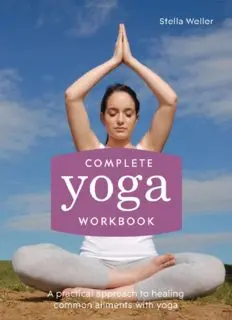
Complete yoga workbook : a practical approach to healing common ailments with yoga PDF
Preview Complete yoga workbook : a practical approach to healing common ailments with yoga
A practical approach to healing common ailments with yoga Stella Weller CONTENTS INTRODUCTION Tree of yoga Asanas Pranayama Meditative practices Relaxation practices Cleansing practices Yoga style PART 1: GETTING STARTED How to use this book What to wear Where to do it When to do it How to do it Precautions Pregnancy The asanas Breathing and meditation Warming up and cooling down PART 2: THE HEALING POWER OF YOGA Bones, muscles and joints Arthritis Back problems Osteoporosis Repetitive Strain Injury (RSI) Breathing and circulation Breathing problems Asthma Blood pressure Digestion and elimination Digestive problems Urinary problems Mental health Anxiety Depression Stress Reproductive system The menopause Menstrual problems Sleep and fatigue Fatigue Sleep disturbances Metabolic disorders Weight problems Immune system Allergies PART 3: WELLNESS ROUTINES The yoga approach 20-minute workout for men and women Alternative 20-minute workout for men and women 10-minute workout for men and women Alternative 10-minute workout for men and women 5-minute workout for men and women Alternative 5-minute workout for men and women Especially for seniors Antenatal routine Postnatal routine Glossary Bibliography Acknowledgements INTRODUCTION A doctor sets a broken bone or brings together the edges of a wound and secures them with sutures. Another doctor prescribes a medicine to halt the progression of a dreaded disease, but it is the body, not the doctor, that brings about the actual healing. Regardless of the cause of damage, healing follows a predictable course that may be divided into four phases: vascular response, inflammation, proliferation and reconstruction. Within seconds of an injury, the body begins the first of these phases to control bleeding and limit the spread of infection. Blood vessels constrict, clotting begins and various protective and healing processes are set in motion. The other three phases follow the first in a beautifully synchronized fashion until the structure and function of the damaged tissues have been repaired and restored, and the equilibrium of the healing system has been re- established. The healing system is composed of all the body’s systems (such as the immune and nervous systems) and also of physiological components such as our mind and our breath. And when treatments work (such as those prescribed by a doctor), it is because they activate the healing mechanisms that are within us. When we are injured or experience a breakdown in health, collaboration between us and our health-care provider (doctor or other qualified professional) usually offers the best chances of a satisfactory outcome. Therefore, let us not underestimate what we, as individuals, can do to contribute to this working relationship. For no matter where we are, we have within us (although often underutilized), natural resources that can promote health and healing: our body, our mind and our breath. These three components of the whole person have been part of the focus of the centuries-old discipline of yoga, and Complete Yoga Workbook will show you how to make them work for you – safely, efficiently and enjoyably. More than 5000 years ago in India, a philosophy known as yoga came into being. The word “yoga” comes from Sanskrit and has various meanings, including “yoke” and “unity”. It implies an integration of every aspect of the human being into a harmonious whole. The principles of yoga were passed by word of mouth from master to student. About 3000 years later, an Indian sage named Patanjali finally recorded these teachings in a now-classical work called Yoga Sutras. This guidebook provided the framework for modern-day yoga practice. The book has something to offer everyone, whatever their age or sex. Yoga can be very beneficial for pregnant women, but they should first seek permission from their doctor. Health educators and fitness instructors will also find it a useful resource. And even if you are not recovering from an illness or injury, you can use the exercises and procedures to enhance your performance in sports, professional dancing and other activities, or to acquire stamina for increased productivity and fulfillment in any endeavour. Enjoy the exercises and savour their endeavour. Enjoy the exercises and savour their resulting health benefits. Tree of yoga In ancient times, yoga was compared to a tree with six branches: bhakti, hatha, jñana, karma, raja and tantra. Each branch represented a particular approach to life. Most people in industrialized societies worldwide now practise hatha yoga. “Ha” means “sun” and “tha”
